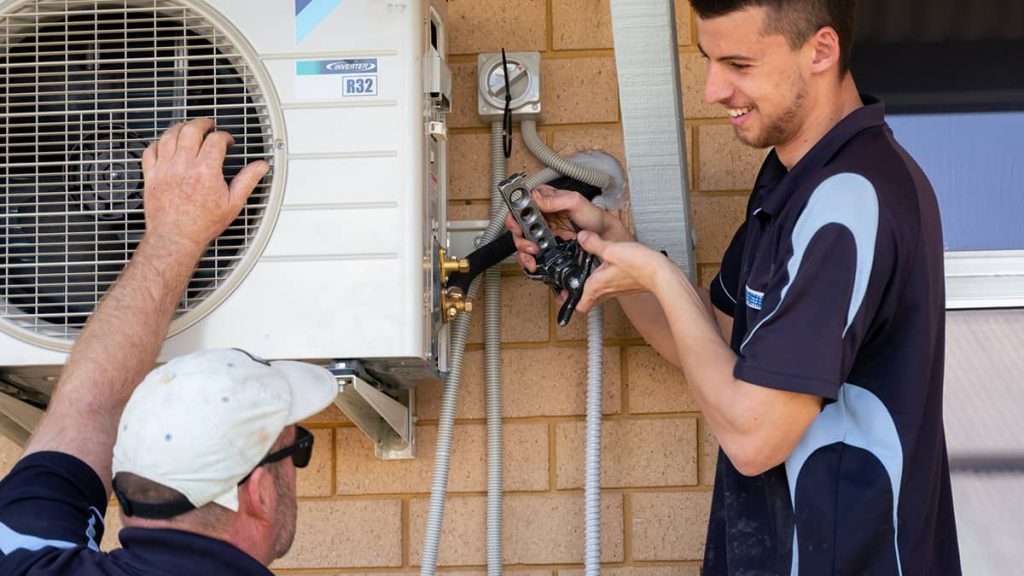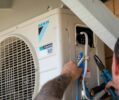Split systems are the most common type of air conditioning in Australian homes. However, before you purchase one, you should understand the benefits and differences between the two, which will help determine whether a single split system or multi-split system is right for your home or office.
What is a single split system?
- A single split system air conditioner is the most versatile cooling and heating option available. Split systems have an outdoor unit and an indoor unit. The outdoor unit connects to a flexible refrigerant conduit pipe.
- The indoor unit is installed on the wall inside your home. It consists of an evaporator and fan, allowing air to flow. The indoor unit cools or heats your space.
- The other part is the outdoor unit, often placed next to the house but usually close to the indoor unit. The outdoor unit consists of a compressor and a fan condenser, letting air flow through the refrigerant line and into the outdoor space.
What is a multi-split system?
- Multi-split systems are also known as multi-zone air conditioning. The system works the same way as a single split system, as described above. However, there is one difference.
- A multi-split system has more than one indoor unit connected to one outdoor compressor, applying multiple air conditioning units to further rooms and areas in the building.
- You can select the appropriate size or capacity of your indoor units based on the site they will cool or heat.
Single split system vs multi-split: Which is more energy efficient?
Both single and multi-split systems are energy-efficient, particularly if you select an appliance made with inverter technology. Such air conditioners have compressors run by a motor. Their motor rotation speeds rely on power supply frequency, meaning the inverter controls power supply frequency, so motor rotation speed is regulated correctly. As a result, compressor operations are adjusted to eliminate waste and use only the energy required, thanks to inverter technology stabilising temperature.
Even if you have multiple indoor units, you do not have to worry about electricity costs. For one, multi-splits are more cost-effective than buying two or more split-type units. You can have three indoor units connected to one outdoor unit. When it comes to electricity consumption, the inverter technology adjusts the compressor load depending on the heat load from the indoor units. As a result, electricity use is less.
What type of split system is right for me?
When deciding between a single split and multi-split system, take into account the size of the home or building. A large house with several rooms may benefit from a multi-split system to enjoy a comprehensive air conditioning solution. Meanwhile, a basic split system will satisfy the cooling or heating requirements for small, single zones.
Obviously, two or more indoor units mean a higher upfront cost. However, if you value flexibility and convenience, a multi-split may be the better option for you. But first, evaluate if the spaces in your home require different temperatures at a given time. This is why offices, hospitals, schools, and large retail stores opt for multi-split aircon.
Think about it; some people have their own preferences when it comes to temperatures. So, if you share the house with several other individuals, you may require varying temperatures during the day. Suppose you are with a group of people in the living area. In that case, you will most likely need a different temperature from the person working in the home office and someone sleeping in the bedroom.
For some people, a single split air conditioner may be more economical than a multi-split. These advantages include:
- More affordable
- Quicker installation
- Less noise (because there’s only one indoor unit)
- Compactness with no trouble of fitting the unit anywhere there’s adequate wall space
- Easy maintenance
However, if you prefer the advantages listed below, a multi-split system may be better for you:
- Get separate controls for each indoor unit for greater flexibility
- Obtain a cheaper cooling and heating solution compared to buying several single split systems
- Enjoy energy efficiency when you run more than one indoor unit with a single outdoor compressor
Split system installation requirements
A split system is easy to install, but it should be professionally installed, whether you have a single or multi-split system. These two types of air conditioning systems have ozone-depleting refrigerant gas; therefore, only certified technicians should handle the appliance.
A professional knows the best place to install both outdoor and indoor units. Typically, the indoor air outlet unit is installed close to the ceiling. Do this in all rooms for a multi-split system.
For the outdoor compressor unit, a little bit more consideration is required. Ideally, it should be placed away from direct sunlight. The installer will ensure that the outdoor unit stands on a flat, firm surface like a concrete slab. In some cases, you may need to attach it to a wall and connect it to sturdy brackets. As mentioned, the outdoor unit should be in close proximity to the indoor air units as possible.
Although we have mentioned that you will only need one outdoor unit, an additional compressor may be required if you have a multi-storey home. That way, the piping from the compressor can run towards the indoor outlet with ease.
Do you need professional advice on a single split system or multi-split? We are the air conditioning experts you need. Contact us today!








